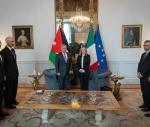You are here
Workshop offers insight into British colonial architecture in Jordan
By Saeb Rawashdeh - Mar 15,2023 - Last updated at Mar 15,2023
AMMAN — British colonial architecture in Jordan was the focal point of a workshop held at the Council for British Research in the Levant (CBRL) Amman Institute on Wednesday.
A presentation at the workshop, titled “Colonial Architecture in Transjordan: the case of As Safawi HS station”, witnessed the participation of Jordanian and British scholars specialised in the history of Transjordan during the British Mandate.
“This research seeks to contribute to the limited but growing collection of research on British colonial architecture in Jordan. This architecture is part of Jordan’s modern history, witness to another world and worthy of protection,” noted Shatha Mubaideen from CBRL Amman Institute.
Mubaideen said that the H5 As-Safawi Station, located in Mafraq Governorate, represents a “rare opportunity” to use archaeological techniques and approaches to the study of contemporary history.
The documentation and analysis helped in understanding the social patterns, behaviours, flow and narratives specific to the H5 station as an element of the Kirkuk-Haifa oil pipeline, Mubaideen highlighted.
Investigating Hijaz Railway, the late Ottoman period and the Arab Revolt, John B. Winterburn, a landscape and conflict archaeologist, noted that Jordan is a “very rich country” in terms of history.
“The first half of the 20th century was a very turbulent period for Jordan, when industrial infrastructure and military resources to provide security played an essential role in the creation of Jordan,” Winterburn said, noting that the telegraph line in 1900 was the area’s first aspect of industrialisation.
“Soon afterwards the Hijaz Railway came, linking Damascus with Medina in 1908,” Winterburn said.
These were colonial enterprises which brought expertise and material from the Western world to Jordan, Winterburn outlined, adding that a distinct architectural style of these buildings has survived until this day.
“Railway stations are a heritage of the late Ottoman period,” Winterburn said.
“Pumping stations immediately became settlements, and roads linked this infrastructure,” Winterburn said
“The oil industry in Iraq put Transjordan in the position of being part of military-political architecture and planning initiatives,” Mubaideen said, adding that the British, French and American political and economic interests in pumping oil from Iraq to the Mediterranean triggered the inception of modern pipelines in the region.
H5 is an enclosed area in the desert containing the pumping installation, living quarters, workshop buildings, storage building and tankage of more than 47 steel and stone buildings, she elaborated.
“The compound had the headquarters of the Employment office of Transjordan and representatives of the medical, accounts, engineering and security departments,” Mubaideen highlighted.
At Wednesday’s workshop, researchers presented the first phase of the project, which included data collection, photographic documentation of the site and research archives in the UK on the site’s history and its surroundings.
Related Articles
AMMAN — While southern Jordan witnesses an abundance of ancient sites, a British archaeologist decided to study the 20th century archaeology
AMMAN — The Hejaz Railway was “a monumental feat of engineering and a triumph of Islamic financing over Western capital, and the last desper
Jordan Hijaz Railway Corporation Director General Salah Lozi and Pakistan’s Ambassador to Jordan Ahsan Azhar Hayat on Monday discussed ways to boost railway cooperation.

















